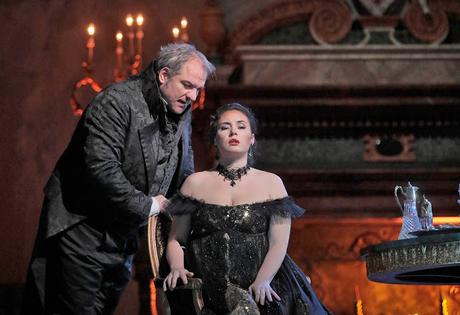by Paul J. Pelkonen

Scarpia (Željko Lučić) menaces Tosca (Sonya Yoncheva) in a rehearsal
of the Metropolitan Opera's new production of Tosca. Photo by Ken Howard © 2017 The Metropolitan Opera.
What is Tosca?
This is Giacomo Puccini's fifth opera, a lean, compact story of two lovers, an artist and a singer caught in the sights of the predatory police chief of Rome. With lust, religious choruses, attempted rape, and a couple of murders, Tosca is one of the most intense and most beloved operas of all time.
What's Tosca about?
Based on a pot-boiling French play, Tosca is the story of the opera singer Floria Tosca. One of the most iconic of Puccini's creations, Tosca is a fiery, jealous woman, possessive of her lover Mario Cavaradossi. When her lover helps a political prisoner escape the clutches of the evil Baron Scarpia, a string of disastrous consequences plays out. It ends badly, but in spectacular fashion.
What's the music like?
Puccini was a master tunesmith, and Tosca is one of his greatest creations. There are short, memorable arias, repeated themes for each of the main characters, and the opera's centerpiece, Tosca's Act II aria "Vissi d'arte." If the soprano does not bring down the house in this scene, she's doing it wrong. The same could be said for "E lucevan le Stella," Cavaradossi's show-stopping number in Act III.
Who's in it?
The Met originally planned to feature tenor Jonas Kaufmann, soprano Kristine Opalais and baritone Sir Bryn Terfel as the opera's three protagonists, with Andris Nelsons conducting. Thanks to a comedy of errors and internal house scandals, opening night now features Sonya Yoncheva as Tosca, Vittorio Grigolo as Cavaradossi and Željko Lučić as Scarpia. The French conductor Emmanuel Villaume replaces James Levine in the orchestra pit. The second cast, appearing in an April run of performances, will feature Anna Netrebko in the title role.
How's the production?
Tosca has the virtue of being a site-specific opera, with the action set in three specific locations in the eternal city of Rome. This production by Sir David McVicar features sets that resemble those locations: the church of Sant'Andrea della Valle, the Palazzo Farnese and the roof of the Castel di Sant'Angelo overlooking the Tiber River. The action of Tosca takes place on June 17th and 18th in the year 1800. To our knowledge, the Met is not installing time-travel devices in an effort to maintain maximum authenticity for the premiere.
Why should I see it?
This is one of Puccini's greatest operas, a two-fisted red-blooded and (for an Italian opera, anyway) feminist story. Did we mention that it opens with a prison break and ends with a stunning suicide?
When does it open?
Tosca steps before the footlights at 6pm on Dec. 31 New Year's Eve. The spring run of the production (those are the shows with Anna Netrebko) opens in April.
Where can I get tickets?
Tickets are available through MetOpera.Org or by calling the box office at (212) 362-6000. You can save the $10 service fees by going to the box office in person at the Met itself, located at 30 Lincoln Center Plaza. Hours: Monday to Saturday: 10am-8pm, Sunday: 12pm-6pm.
What recording should I buy?
Coro e Orchestra della Scala cond. Victor de Sabata (EMI/WBC, 1953)
Floria Tosca: Maria Callas
Mario di Cavaradossi: Giuseppe di Stefano
Baron Scarpia: Tito Gobbi
The 1953 mono EMI set (now reissued on Warner Brothers Classics) is the classic Maria Callas recording of Tosca. All of her affectations, flaws and nuances are present, in magnificent (and immediate) EMI mono sound. The "Vissi d'arte" is divine. Di Stefano had not yet begun his steep vocal decline, and Gobbi is a perfect bastard of a police chief. Accept no substitutes! (Note: Do not buy the 1997 remastered version
Vienna Philharmonic cond. Herbert von Karajan (Decca, 1962)
Floria Tosca: Leontyne Price
Mario di Cavaradossi: Giuseppe di Stefano
Baron Scarpia: Giuseppe Taddei
This is Leontyne Price's first recorded Tosca, and it remains a superb set. Although di Stefano had roughened over the nine years that separate these recordigs, he is still a tremendous presence as Cavaradossi. Ms. Price brings a different, compelling interpretation to the title role and Taddei is a nasty Scarpia. Herbert von Karajan and the Vienna forces make a formidable pairing, and their playing is inspired. So is the recording: an early example of the Decca Sonicstage technique developed by producer John Culshaw.

